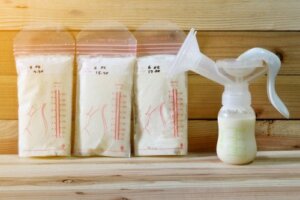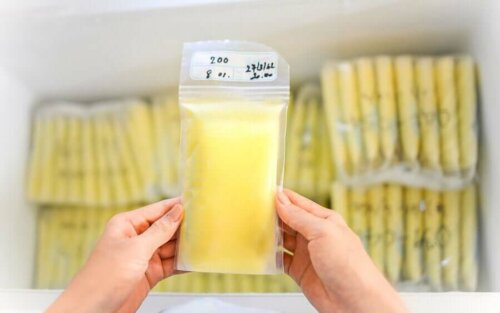How To Store Breast Milk

Just because mothers work or study doesn’t mean that they have to stop breastfeeding. In fact, if you know how to store breast milk properly, you’ll have more options when it comes to bottle feeding.
To understand this, let’s take a brief look at some of the issues.
The American Academy of Pediatrics states that breast milk is the only truly adequate food during the first 6 months of a child’s life, and it has been proven to provide multiple benefits for the health of the baby.
For this reason, experts consider that it’s convenient for the baby to be breastfed until 12 months of age, and even longer if the mother or child wishes.
As the mother has to continue with her daily routine throughout breastfeeding, doctors recommend that she learns how to store breast milk properly to make it easier for her to combine feeding her baby with her daily life.
General recommendations when it comes to storing breast milk

You may also be interested in: Skin Changes During Pregnancy
Where to store breast milk and how long for
There are two types of containers to store breast milk properly. The first is a bottle, or a glass or plastic container, that has a tight seal. The second is a sterile bag, which must be airtight.
For both of these, you should store only the amount that the baby consumes in one meal. For example, if the baby is used to taking 4 ounces, it’s recommended not to deposit more than 4 ounces in each container. Again, always ensure there is a label with the date of extraction.
Storage time depends on the temperature at which you store it. According to advice from the Center for Disease Control and Prevention, breast milk stays in good condition for up to 4 hours if kept at room temperature. If stored in the fridge, it can last around 4 days.
Finally, if you want to store it for 12 months, put the bottle or bag in the freezer. However, so that it doesn’t lose any quality and in order to keep its properties you should consume it within 6 months.
Methods of preserving breast milk

- Keep breast milk cold before refrigerating it.
- If you’re going to use it in the coming days, it’s best to store it at the back of the refrigerator.
- If you’re going to use it in a matter of weeks, it’s best to freeze breast milk. You should do this as soon as possible.
- Don’t fill containers more than three-quarters full, as breast milk expands when frozen.
- The containers should preferably be located at the back of the freezer, as the temperature is more consistent there.
Other facts to take into account
Stored breast milk tends to separate into layers. Before giving it to the baby, you should shake the bottle gently. If you overdo it, some properties of the food may be altered.
Thawed milk stays good for two hours at room temperature, or 24 hours in the fridge. After thawing, it cannot be refrozen. The best way to defrost it is to put it inside the bottle and place it in a container with warm water.
Furthermore, never thaw it in the microwave or in boiling water. All of this is explained by this publication of the Spanish Association for the Promotion and Support of Breastfeeding.
Discover more: Skin Changes During Pregnancy
It’s very common for milk to change its color and smell a little during refrigeration or freezing. If all the instructions for storing breast milk have been followed, there’s no need to worry. If the smell is very intense, it’s probably not suitable for consumption, so it’s best to get rid of it.
All cited sources were thoroughly reviewed by our team to ensure their quality, reliability, currency, and validity. The bibliography of this article was considered reliable and of academic or scientific accuracy.
- American Academy of Pediatrics. (n.d.). American Academy of Pediatrics https://www.aap.org/en-us/Pages/Default.aspx
- Arias Borda, M. L. (2012). Efectividad del Programa Extracción y Almacenamiento de Leche Materna en la mejora de los conocimientos y practicas en Puérperas Tardías del Centro de Salud Materno Infantil del Rímac. http://168.121.49.87/bitstream/handle/urp/327/Arias_ml.pdf?sequence=1&isAllowed=y
- LA LECHE, A. D. E., LA LECHE, C. A., & MATERNA, G. P. A. L. L. ALMACENAMIENTO Y PREPARACIÓN. https://www.chw.org/-/media/publication-media-library/2019/07/24/23/29/1401sp.pdf
- Fernández-Vegue, M. G. 23. Conservación y uso de la leche materna extraída. Asociación Española de Promoción y Apoyo a la Lactancia Materna. http://aelama.org/wp-content/uploads/2019/09/Pregunta-23.pdf
This text is provided for informational purposes only and does not replace consultation with a professional. If in doubt, consult your specialist.








